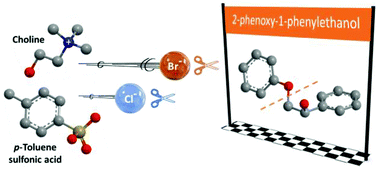Novel insights into biomass delignification with acidic deep eutectic solvents: a mechanistic study of β-O-4 ether bond cleavage and the role of the halide counterion in the catalytic performance†
Abstract
Development of innovative technologies for efficient, yet eco-friendly, biomass delignification is required to achieve higher sustainability than traditional processes. In this context, the use of deep eutectic solvents (DESs) for the delignification process could fulfil these requirements and stands today as a promising alternative. This work focuses on understanding the fundamental chemistry behind the cleavage of the β-O-4 ether bond present in 2-phenoxy-1-phenylethanol (PPE), a lignin model compound, with three acidic DESs, including Propionic acid/Urea (PA : U), Lactic acid/Choline Chloride (LA : ChCl) and p-Toluenesulphonic acid/Choline chloride (pTSA : ChCl). The acidic nature of each DES influenced the efficiency of PPE cleavage and determined the extent of further side reactions of cleavage products. Although PA : U (2 : 1) demonstrated the ability to dissolve lignin, it is unable to cleave β-O-4 ether linkage in PPE. On the other hand, LA : ChCl (10 : 1) allowed PPE cleavage, but an esterification between the PPE and lactic acid as well as oligomerization of lactic acid was detected. Among the examined solvents, pTSA : ChCl (1 : 1) demonstrated the highest performance in the PPE cleavage, although the high acidity of this system led to the condensation of cleavage products with prolonged time. The presence of water decreases the ability of DESs for cleavage, but the extension of undesired side reactions was also reduced. Finally, the analysis of intermediates and products of the reactions allowed the identification of a chlorinated species of PPE that precedes the cleavage reaction. A kinetic study using pTSA : ChCl (1 : 1) and pTSA : ChBr (1 : 1) was performed to unveil the role of the halide counterion present in DESs in the cleavage of the β-O-4 ether bond and a new reaction mechanism was herein proposed and supported by density functional theory (DFT) calculations.

- This article is part of the themed collection: International Symposium on Green Chemistry 2019


 Please wait while we load your content...
Please wait while we load your content...